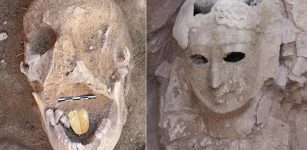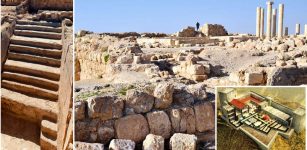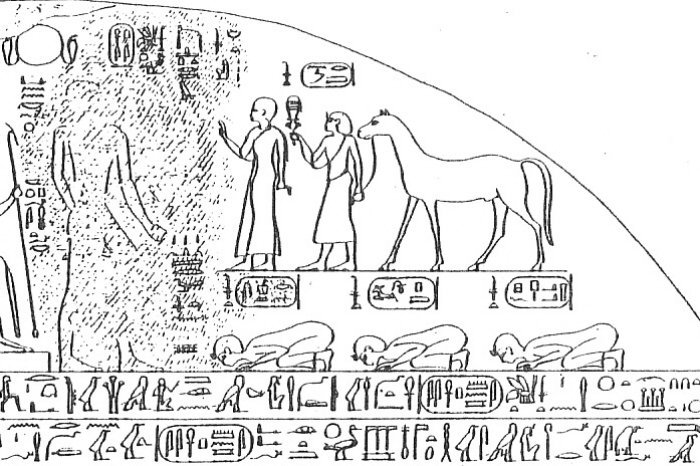Ancient Stela Of Piankhi – King Of Napata, Rightful Ruler And Maintainer Of Maat
A. Sutherland - AncientPages.com - The Victory Stela of King Piankhi is an important surviving artifact related to the historical period when the Nubian King Piye (formerly called Piankhi) invaded and conquered Egypt, that at the time, had no central power.
He came into possession of Upper Egypt and established the 25th Egyptian Dynasty, named also Kushite or Napata Dynasty.
Known as Piankhi the Great, he was proclaimed King of the old kingdom of Kush and ruled ca. 743-712 BC. It is believed Piankhi was a son of Kashta of the Kushite Dynasty and his mother was Pebatjma, a Nubian queen dated to the 25th Dynasty of Egypt.
In his book "World's Great Men of Color", J. A. Rogers wrote about Piankhi:
"During his reign of approximately thirty-two years (c. 744 -712 B.C.), Piankhi expanded greatly the boundaries of his ancestral domain through the force of arms; but he never engaged in military activity if it could be gracefully avoided, and the national interests and imperial honor otherwise preserved. In short, Piankhi was primarily a patron of the pursuits of peace…"
Stela Tells About The King’s Deeds
The stela, with a 159-line inscription, recounts Piankhi’s accomplishments and justifies his kingship over all of Egypt.
It describes Piankhi’s military campaign northward and how he achieved his success.
It is said that Piankhi, the Nubian king and pharaoh of Egypt, fought against a coalition organized by the princes (Nimlot from Hermopolis and princes Osorkon IV, Iupet II, and Sheshonq V) of the Delta under the leadership of Tefnakht.
After receiving the surrender of Hermopolis in Middle Egypt, and conquering Memphis, Piankhi received oaths of fealty and tribute from all his conquered adversaries.
The inscription also says that Piankhi had certain and rather unusual personality traits. As a conqueror, he favored treaties and alliances instead of bloodshed, forgave his enemies and made special devotions to the gods of the northern towns fallen to his armies.
Despite his victory, Piankhi did not expand his rule over the north of Egypt and focused his reign over Thebaid (a region of southernmost nomes of Upper Egypt, from Abydos to Aswan) and the western desert oases.
His next step was to withdraw to Napata, in the Kingdom of Kush, located along the Nile River just south of Egypt, in an area between modern-day Aswan and Meroë, Sudan.
See also:
Ancient Great City Of Napata In The Kingdom Of Kush
Sistrum: A Magical And Sacred Ancient Egyptian Musical Object
Maat – Ancient Egypt’s Most Important Religious Concept
On the walls of his new temple, Piankhi memorialized his success on the stela and remained in his capital until he died and was buried in the royal cemetery at el-Kurru, just outside the capital of Napata, in 714 BC.
He was considered by many a holy king who ruled by the will of Amun. He was also a rightful ruler who deeply respected and maintained Maat principles.
What Does The Stela Depict?
The large and impressive stela of pink granite, with a rounded top that measures 180 cm by 180 cm (about 6ft) high and 43 cm thick, is now stored in the Museum of Cairo.
It was discovered (almost intact) in the temple of the god Amun-Re at Gebel Barkal (Napata) by a native Egyptian officer of the Sudanese government in 1862 and the artifact dates back to the 21st year of Piankhi’s reign.
As described by Breasted, J. H. in “Ancient Records of Egypt”, the Victory Stela depicts the god Amun of Napata enthroned and accompanied by the goddess Nut, standing behind him. Piankhi, standing behind these two divine figures, is approached by Namlot, the ruler of Hermopolis, who is shown leading a horse and shaking a sistrum. Above him, there is a short inscription: "King Namlot."
Drawing of the upper-right part of the victory stele of pharaoh Piankhi (Piye), depicting Piye being tributed by four conquered Nile Delta rulers: Nimlot (holding a horse) and his queen (before him), Osorkon IV, Iuput II, and Peftjauawybast. Image credit: Wikipedia
A woman, standing with an uplifted right hand, preceding Namlot, represents "the king's-wives," the women of Namlot, who appeared before Piankhi in the palace at Hernopolis. The three defeated Libyan kings (Osorkon, Yewepet, and Pefnefdibast ) bow themselves down at Piankhi’s feet, recognizing his total supremacy. Behind Nut, there are five other princes approaching the king Piankhi and all of them are showed kissing the earth at Piankhi’s feet.
The Piankhi Stela does not give any hint of the development of the Nubian Kingdom, instead, it discloses its existence as a fully-developed power and strongly suggests that King Piankhi must have come to the throne in Napata about 741 BC.
Written by – A. Sutherland AncientPages.com Staff Writer
Copyright © AncientPages.com All rights reserved. This material may not be published, broadcast, rewritten or redistributed in whole or part without the express written permission of AncientPages.com
Expand for referencesReferences:
David Bourke O'Connor, David P. Silverman, Ancient Egyptian Kingship
A. Lobban Jr. Historical Dictionary of Ancient and Medieval Nubia
Academia.edu/S. Schellinger
http://www.academia.edu/7757030/The_Victory_Stela_of_Piankhi_ca._725_BCE_
Breasted, J. H. Ancient Records of Egypt
More From Ancient Pages
-
 Scribes: One Of The Noblest And Highly Recommended Professions In Ancient Egypt
Featured Stories | May 10, 2023
Scribes: One Of The Noblest And Highly Recommended Professions In Ancient Egypt
Featured Stories | May 10, 2023 -
 Strange Ancient And Medieval Encounters With Unusual Beings Reported And Documented
Featured Stories | Jan 15, 2024
Strange Ancient And Medieval Encounters With Unusual Beings Reported And Documented
Featured Stories | Jan 15, 2024 -
 Alexander Nevsky: Grand Prince Of Novgorod, Skilled Fighter, Quick–Thinking Strategist Who Defeated Swedish And German Invaders
Featured Stories | Feb 22, 2019
Alexander Nevsky: Grand Prince Of Novgorod, Skilled Fighter, Quick–Thinking Strategist Who Defeated Swedish And German Invaders
Featured Stories | Feb 22, 2019 -
 Explorer Discovered A Lost Underground World Beneath Big Sur In North America – But Why Cannot Anyone Else Find It Now?
Ancient Mysteries | Feb 12, 2019
Explorer Discovered A Lost Underground World Beneath Big Sur In North America – But Why Cannot Anyone Else Find It Now?
Ancient Mysteries | Feb 12, 2019 -
 Two Well-Preserved Shipwrecks Found By Swedish Maritime Divers In Baltic Sea
Archaeology | Jan 30, 2018
Two Well-Preserved Shipwrecks Found By Swedish Maritime Divers In Baltic Sea
Archaeology | Jan 30, 2018 -
 Conwy Castle In Snowdonia: Outstanding Medieval Fortification In Europe
Featured Stories | Oct 16, 2018
Conwy Castle In Snowdonia: Outstanding Medieval Fortification In Europe
Featured Stories | Oct 16, 2018 -
 Ancient Egyptian Mummies With Golden Tongues Discovered In Alexandria
Archaeology | Feb 3, 2021
Ancient Egyptian Mummies With Golden Tongues Discovered In Alexandria
Archaeology | Feb 3, 2021 -
 The 5,500-Year-Old Underground Rock Settlement With Illuminated Galleries In Ancient City Of Hadrianopolis, Turkey
Archaeology | Sep 18, 2023
The 5,500-Year-Old Underground Rock Settlement With Illuminated Galleries In Ancient City Of Hadrianopolis, Turkey
Archaeology | Sep 18, 2023 -
 Rare Ancient Drawings Offer Evidence Moluccan Boats Visited Australia From Indonesia?
Archaeology | May 31, 2023
Rare Ancient Drawings Offer Evidence Moluccan Boats Visited Australia From Indonesia?
Archaeology | May 31, 2023 -
 Ritual Bath In Herod’s Fortress Found In Ruins Of Machaerus, East Of Jordan River
Archaeology | Jun 16, 2017
Ritual Bath In Herod’s Fortress Found In Ruins Of Machaerus, East Of Jordan River
Archaeology | Jun 16, 2017 -
 Suprising Discovery Of A Well-Preserved Ancient Roman Road In London, UK
Archaeology | Nov 19, 2024
Suprising Discovery Of A Well-Preserved Ancient Roman Road In London, UK
Archaeology | Nov 19, 2024 -
 Medieval Celtic Mystery Written In Konungs Skuggsja – The King’s Mirror
Featured Stories | Sep 13, 2018
Medieval Celtic Mystery Written In Konungs Skuggsja – The King’s Mirror
Featured Stories | Sep 13, 2018 -
 Hnefatafl: Ancient Viking Board Game “King’s Table” Popular In Medieval Scandinavia
Ancient History Facts | Mar 20, 2016
Hnefatafl: Ancient Viking Board Game “King’s Table” Popular In Medieval Scandinavia
Ancient History Facts | Mar 20, 2016 -
 Raven Mocker And Cannibal Body Snatchers In Cherokee Mythology
Featured Stories | Jun 13, 2019
Raven Mocker And Cannibal Body Snatchers In Cherokee Mythology
Featured Stories | Jun 13, 2019 -
 World’s Oldest Tattoo Tools Discovered In Tennessee, North America
Archaeology | May 2, 2018
World’s Oldest Tattoo Tools Discovered In Tennessee, North America
Archaeology | May 2, 2018 -
 Yokai Kijo (Kidjo): Demoness, Cannibal With Hideous Heart Is A Moral Reminder In Japanese Beliefs
Featured Stories | Apr 28, 2024
Yokai Kijo (Kidjo): Demoness, Cannibal With Hideous Heart Is A Moral Reminder In Japanese Beliefs
Featured Stories | Apr 28, 2024 -
 Mysterious Gobi Sea And A Huge Land Inhabited By The Real Sons Of God
Featured Stories | Aug 20, 2018
Mysterious Gobi Sea And A Huge Land Inhabited By The Real Sons Of God
Featured Stories | Aug 20, 2018 -
 Legendary Bladud: The Flying King And Historical Founder Of Bath, England
Featured Stories | Mar 8, 2016
Legendary Bladud: The Flying King And Historical Founder Of Bath, England
Featured Stories | Mar 8, 2016 -
 Central Asia Identified As A Key Region For Human Ancestors
Archaeology | Oct 22, 2022
Central Asia Identified As A Key Region For Human Ancestors
Archaeology | Oct 22, 2022 -
 Omphalos – Mysterious Ancient Sacred Object And Its Meaning
Artifacts | May 24, 2017
Omphalos – Mysterious Ancient Sacred Object And Its Meaning
Artifacts | May 24, 2017




